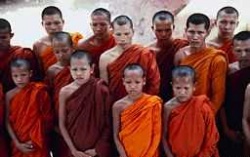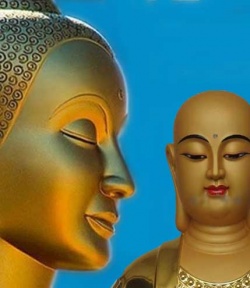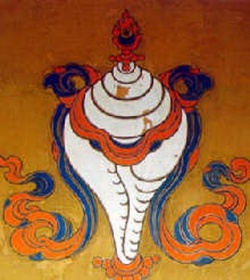Tibetan Monasteries: Islands of Peace, or Oceans of Noise?
by Georges Dreyfus
The centrality of sound in Tibetan monastic life, about which I will have more to say, is obvious to anybody who has stayed in any large Tibetan monastery. As I have stressed, a Tibetan monastery is devoted not to meditation but to rituals and sometimes studies. Far from being an island of peace and quiet like a hermitage, it is filled with activities and almost constant noise. It is, in Anne Klein’s words, “an arena suffused with sound.”6
The day often starts with a chanted ritual service done on behalf of a sponsor. It continues with the cacophony of memorization, as each monk loudly repeats a different passage to his own rhythm and tune. Later on, further ritual services or sessions of debate may be conducted, while the young monks who have not yet finished their preliminary memorization keep reciting their texts at the top of their transmissions. It is only at lunchtime that relative quiet descends on the monastery. After eating, monks relax. Friendly chats take place here and there, but loud discussions are frowned on. There is usually less noise during the first part of the afternoon, when fewer monks memorize and many either read or engage in the different tasks that have been assigned to them. But the noise picks up during the evening, when the main sessions of debate are held. Then the air is filled with the roar from the debating courtyard. When debates end, monks start their recitation sessions, as described above. At this point, hundreds of monks may be reciting as loudly as they can, and the cacophony can reach an almost unimaginable level. Around ten the noise diminishes, and by eleven only scattered recitations can be heard. There are times, however, when some monks decide to spend the whole night reciting. Religious festivals such as the full moon of the fourth Tibetan month, which commemorates the Buddha’s enlightenment as well as his passing away, are often chosen for such exercises. At these auspicious times, the practice of virtue is considered much more effective.
Reading or reciting aloud is considered virtuous for several reasons. Vocalizing a text in a rhythmic pattern helps it penetrate one’s mind, where it starts to take on a life of its own. One finds oneself spontaneously repeating the words. Such absorption of religious texts is thought to have soteriological value. The virtuous nature of recitation is also tied to a view of the world as alive with a number of invisible entities. Traditional Tibetans believe that countless gods and spirits live around us in trees, springs, houses, and rocks. Loud recitation attracts these entities, who are then able to hear the Buddhist teaching (an opportunity usually denied by their birth); hence, it is thought to be a highly meritorious form of giving (jinpa, dāna). Geshé Rabten recalls matter-of-factly,
There was a cemetery not far from our monastery; it was inhabited by many spirits and other non-human forms of life. It is said in the scriptures that if one recites kind words of dharma in the direction of such a place, it benefits these creatures. Thus, moved to be of service to them, at night when I was reciting I would sometimes turn towards this cemetery, and in a loud voice chant some fine verses of dharma.7
Tibetans therefore view loud recitation as valuable in and of itself. It helps other sentient beings, particularly if it is aesthetically pleasing.8
A small incident illustrates the religious value of recitation and its sometimes unexpected results. During the 1960s, Trijang Rinpoché visited the three monastic seats then located at Buxa in Northeast India. One of the Dalai Lama (tā la’i bla ma)’s tutors, he was an extremely famous teacher and the guru of most of the Geluk monks. Students are supposed to please their guru by offering them their services as well as presents, and the best offering is one’s virtuous practice. What better way to rejoice Rinpoché than a highly virtuous action such as a full-night recitation? Or at least so a young monk thought. Thus, he positioned himself near Rinpoché’s room and proceeded to spend the whole night reciting at full volume all the texts he had ever memorized. Rinpoché’s reaction, alas, was not what he had expected. “Who is the idiot who kept me awake the whole night?” was his reported comment. Most Tibetan monks, however, are much less sensitive to disturbances than was Rinpoché, and they carry on their normal activities, including study or sleep, in the greatest uproar.
Still, one may wonder about the utility of all this noise. Doesn’t it interfere with the learning process, much as the faithful disciple’s loud recitation prevented Trijang Rinpoché’s sleep? The counterintuitive answer is that the noise of monasteries in fact supports and reinforces the learning process – particularly memorization. Monks report that far from being distracted by the sounds of other monks’ memorizations, they find them helpful to their own practice. Learning is not just individual but interpersonal as well. When students hear each other, their energy and focus are reinforced. They are supported by the feeling of participating in a common task and pushed to memorize more than they might on their own. At times, a kind of competition develops in which students try to outlast each other, vying to produce the last tune to be heard.
[6] Anne Klein, comp., trans., and ed., Path to the Middle: Oral Madhyamika Philosophy in Tibet (Albany: State University of New York Press, 1994), 6.
[7] Geshe Rabten, The Life and Teaching of Geshé Rabten: A Tibetan Lama’s Search for Truth, trans. and ed. B. A. Wallace (London: Allen and Unwin, 1980), 81.
[8] The example of the Indian master Sthiramati (fifth century C.E.) is often cited to demonstrate the value of recitation. He was a dove when he listened with reverence to Vasubandhu’s melodious recitation. As a result he was reborn as a human being and shortly after his birth he started to inquire about Vasubandhu’s where abouts. See Tāranātha’s History of Buddhism in India, trans. Lama Chimpa and A. Chattopadhyaya, ed. D. Chattopadhyaya (1970; reprint, Calcutta: Bagchi, 1980), 179-80.


